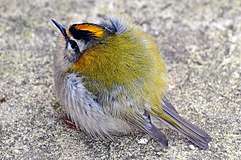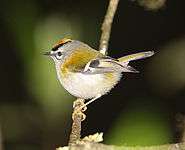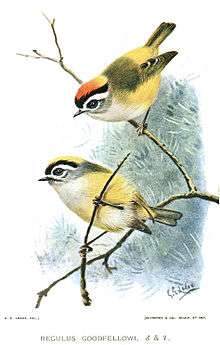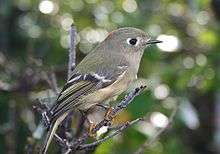Kinglet
A kinglet or crest is a small bird in a group that is sometimes included in the Old World warblers, but is frequently placed in its own family, Regulidae, because of resemblance to titmice. "Regulidae" is derived from the Latin word regulus for "petty king" or prince, and refers to the coloured crowns of adult birds. This family has representatives in North America and Eurasia. There are seven species in this family; one, the Madeira firecrest, Regulus madeirensis, was only recently split from common firecrest as a separate species. One species, the ruby-crowned kinglet, differs sufficiently in its voice and plumage to occasionally be afforded its own genus, Corthylio.
| Kinglets | |
|---|---|
| Goldcrest (Regulus regulus) in Japan | |
| Scientific classification | |
| Kingdom: | Animalia |
| Phylum: | Chordata |
| Class: | Aves |
| Order: | Passeriformes |
| Family: | Regulidae Vigors, 1825 |
| Genus: | Regulus Cuvier, 1800 |
| Species | |
|
See text | |
Description
Kinglets are among the least of all passerines, ranging in size from 8 to 11 cm (3 to 4.5 in) and weighing 6–8 g (0.21–0.28 oz); the sexes are the same size. They have medium-length wings and tails, and small needle-like bills. The plumage is overall grey-green, offset by pale wingbars, and the tail tip is incised. Five species have a single stiff feather covering the nostrils, but in the ruby-crowned kinglet this is replaced by several short, stiff bristles. Most kinglets have distinctive head markings, and the males possess a colourful crown patch. In the females, the crown is duller and yellower. The long feathers forming the central crown stripe can be erected; they are inconspicuous most of the time, but are used in courtship and territorial displays when the raised crest is very striking.[1]
There are two species in North America with largely overlapping distributions, and two in Eurasia that also have a considerable shared range. In each continent, one species (goldcrest in Eurasia and golden-crowned kinglet in North America) is a conifer specialist; these have deeply grooved pads on their feet for perching on conifer twigs and a long hind toe and claw for clinging vertically. The two generalists, ruby-crowned kinglet and common firecrest, hunt more in flight and have smoother soles, shorter hind claws and a longer tail.[1]
Taxonomy
The kinglets are a small group of birds sometimes included in the Old World warblers but frequently given family status,[2] especially as recent research showed that, despite superficial similarities, the crests are taxonomically remote from the warblers.[3][4] The names of the family, Regulidae, and its only genus, Regulus, are derived from the Latin regulus, a diminutive of rex, "a king",[5] and refer to the characteristic orange or yellow crests of adult kinglets. The kinglets were allocated to the warbler genus Sylvia by English naturalist John Latham in 1790,[6] but moved to their current genus by French zoologist Georges Cuvier in 1800.[7]
Several forms have only recently had their status clarified. The Madeira firecrest was formerly considered to be a subspecies, R. i. madeirensis, of the common firecrest R. ignicapillus. A phylogenetic analysis based on the cytochrome b gene showed that the Madeiran form is distinct at the species level from the firecrest nominate subspecies R. i. ignicapillus. Cytochrome b gene divergence between the Madeira firecrest and the European bird is 8.5%, comparable with the divergence level between other recognised Regulus species, such as the 9% between the goldcrest and the golden-crowned kinglet.[1] The split was accepted by the Association of European Rarities Committees (AERC) in 2003,[8] but some authorities, like Clements, have not yet recognised the new species.[9] The golden-crowned kinglet is similar in appearance to the common firecrest and has been considered to be its New World equivalent, but it is actually closer to the goldcrest.[1]
Goldcrests from the Canary Islands are particularly distinctive having a black forehead, pink-buff underparts and a darker closed wing,[10] and have been sometimes treated either as a subspecies of the common firecrest or as a different Regulus species altogether.[11] They were sometimes called the Tenerife goldcrest, no matter which of the islands they lived on; however, a 2006 study of the vocalisations of these birds indicate that they actually comprise two subspecies of the Goldcrest that are separable on voice; R. r. teneriffae occurring on Tenerife and the newly described subspecies, R. r. ellenthalerae, occurring on the smaller islands of La Palma and El Hierro.[12] The three goldcrest taxa on the Azores, Santa Maria goldcrest, Sao Miguel goldcrest and Western Azores goldcrest, represent recent colonisations from Europe, and are best treated as subspecies.[13]
The relationships of the flamecrest or Taiwan firecrest (Regulus goodfellowi) of Taiwan have also been a source of much debate. It is sometimes viewed as a race of firecrest, but its territorial song resembles those of the Himalayan races of goldcrest, and genetic data show that it is the closest relative of that species, and, despite its alternative name, only distantly related to the firecrest.[14] The flamecrest diverged from the Goldcrest 3.0–3.1 mya (million years ago).[15]
Most members of the genus Regulus are similar in size and colour pattern. The exception is the ruby-crowned kinglet, the largest species, which has a strongly red crest and no black crown stripes. It has distinctive vocalisations, and is different enough from the Old World kinglets and the other American species, the golden-crowned kinglet, to be sometimes assigned to a separate genus, Corthylio.[1]
Species
| Species in taxonomic sequence | |||
|---|---|---|---|
| Common and binomial name | Image | Description | Range |
| Goldcrest Regulus regulus |
 |
Olive-green upperparts, buff-white underparts and a plain face with conspicuous black irides. The crown of the head has black sides and a narrow black front, and a bright crest, yellow with an orange centre in the male, and entirely yellow in the female.[16] | Most of Europe and Asia |
| Common firecrest Regulus ignicapilla |
 |
Bright olive-green upperparts with bronze shoulder patches, and whitish underparts with brownish-grey on the breast and flanks. The head has a black eye stripe, long white supercilium, and a crest, bright yellow in the female and mainly orange in the male.[17] | Southern Europe and North Africa |
| Madeira firecrest Regulus madeirensis |
 |
Compared to the common firecrest, this species has a longer bill and legs, a shorter white supercilium, more black on the wings and a deeper golden-bronze shoulder patch; the male's crest is duller orange.[18] | Madeira |
| Taiwan firecrest or flamecrest Regulus goodfellowi |
 |
Upperparts green, rump and flanks yellow, and underparts are buff. There is a white wing bar. The crown has black stripes and a crest, orange-yellow in male and yellow in female. White around the eye and a white supercilium. Throat and neck sides are grey.[19][20] | Taiwan |
| Golden-crowned kinglet Regulus satrapa |
.jpg) |
Olive-grey upperparts and white underparts. They have white wing bars, a black stripe through the eyes and a yellow crown surrounded by black. The adult male has an orange patch in the middle of the yellow crown.[21] | North America |
| Ruby-crowned kinglet Regulus calendula |
 |
Grey-green upperparts and olive-buff underparts.[22] A relatively plain face and head with broken white eye ring. The male has a scarlet-red crown patch, which is usually concealed by the surrounding feathers.[23] | North America |
Fossils
There are a few Pleistocene (2.6 million to 12,000 years BP) records from Europe of extant Regulus species, mostly goldcrests or unidentifiable to species. The only fossil of an extinct Regulus is a left ulna from 2.6–1.95 mya in Bulgaria, which was identified as belonging to an extinct species, Regulus bulgaricus. The goldcrest lineage diverged from this apparent ancestor of the common firecrest in the Middle Pleistocene.[24]
Distribution and habitat
Kinglets are birds of the Nearctic and Palearctic realms, with representatives in temperate North America, Europe and Asia, northernmost Africa, Macaronesia and the Himalayas. They are adapted to conifer forests, although there is a certain amount of adaptability and most species will use other habitats, particularly during migration. In Macaronesia, they are adapted to laurisilva and tree heaths.[1]
Behaviour
Diet and feeding
The tiny size and rapid metabolism of kinglets means that they must constantly forage in order to provide their energy needs. They will continue feeding even when nest building. Kinglets prevented from feeding may lose a third of their body weight in twenty minutes and may starve to death in an hour. Kinglets are insectivores, preferentially feeding on insects such as aphids and springtails that have soft cuticles. Prey is generally gleaned from the branches and leaves of trees, although in some circumstances prey may be taken on the wing or from the leaf litter on the ground.
Life cycle
Kinglet nests are small, very neat cups, almost spherical in shape, made of moss and lichen held together with spiderwebs and hung from twigs near the end of a high branch of a conifer. They are lined with hair and feathers, and a few feathers are placed over the opening. These characteristics provide good insulation against the cold environment. The female lays 7 to 12 eggs, which are white or pale buff, some having fine dark brown spots. Because the nest is small, they are stacked in layers. The female incubates; she pushes her legs (which are well supplied with blood vessels, hence warm) down among the eggs. A unique feature of kinglets is the "size hierarchy" among eggs, with early-laid eggs being smaller than later ones.[25]
Eggs hatch asynchronously after 15 to 17 days. The young stay in the nest for 19 to 24 days. After being fed, nestlings make their way down to the bottom of the nest, pushing their still-hungry siblings up to be fed in their turn (but also to be cold).
Kinglets are the most fecund and shortest-living of all altricial birds,[26] and probably the shortest-lived apart from a few smaller galliform species. Adult mortality for the goldcrest is estimated at over 80 percent per year[27] and the maximum lifespan is only six years.[28]
Status
The four continental Regulus species all have very large ranges and populations. The two single-island endemics are common within their habitat, and are not thought to be at risk. All kinglets are therefore classified as Least Concern on the IUCN Red List.[29]
References
- Martens, Jochen; Päckert, Martin "Family Regulidae (Kinglets & Firecrests)" pp. 330–349 in Del Hoyo, Josep; Elliott, Andrew; Christie, David A., eds. (2006). Handbook of the Birds of the World, Volume 11: Old World Flycatchers to Old World Warblers. Barcelona, Spain: Lynx Edicions. ISBN 978-84-96553-06-4.
- Monroe, Burt L. (February 1992). "The new DNA-DNA avian classification: What's it all about?". British Birds. 85 (2): 53–61.
- Barker, F Keith; Barrowclough, George F; Groth, Jeff G (2002). "A phylogenetic hypothesis for passerine birds: taxonomic and biogeographic implications of an analysis of nuclear DNA sequence data" (PDF). Proceedings of the Royal Society of London B. 269 (1488): 295–308. doi:10.1098/rspb.2001.1883. PMC 1690884. PMID 11839199.
- Spicer, Greg S; Dunipace, Leslie (2004). "Molecular phylogeny of songbirds (Passerifor-mes) inferred from mitochondrial 16S ribosomal RNA gene sequences" (PDF). Molecular Phylogenetics and Evolution. 30 (2): 325–335. doi:10.1016/S1055-7903(03)00193-3. PMID 14715224.
- Brookes, Ian (editor-in-chief) (2006). The Chambers Dictionary, ninth edition. Edinburgh: Chambers. pp. 223, 735, 1277. ISBN 978-0-550-10185-3.
- Latham, John (1790). Index ornithologicus, sive, Systema ornithologiae, complectens avium divisionem in classes, ordines, genera, species, ipsarumque varietates, adjectis synonymis, locis, descriptionibus, &c (in Latin). ii. London: Leigh & Sotheby. p. 548.
- Cuvier, Georges (1800). Lecons d'anatomie comparee de M. G. Cuvier, Recueillies et publiees sous ses yeux, par C. Dumeril et Duvernoy (in French). 1, table 2. Paris: Crochard et cie.
- AERC Taxonomy Committee (2003). AERC TAC's Taxonomic Recommendations (PDF). Association of European Rarities Committees. p. 22.
- Clements, J F; Schulenberg, T S; Iliff, M J; Sullivan, B L; Wood, C L. "The Clements checklist of birds of the world: Version 6.4". Cornell University Laboratory of Ornithology. Archived from the original on 21 August 2010. Retrieved 30 July 2010.
- Mullarney, Killian; Svensson, Lars; Zetterström, Dan; Grant, Peter J. (1999). Collins Bird Guide. London: Collins. p. 336. ISBN 978-0-00-219728-1.
- Löhrl, Hans; Thaler, Ellen; Christie, David A (September 1996). "Status and behaviour of the Tenerife Kinglet". British Birds. 89: 379–386.
- Päckert, Martin (2006). "Song dialects as diagnostic characters—acoustic differentiation of the Canary Island Goldcrest subspecies Regulus regulus teneriffae Seebohm 1883 and R. r. ellenthalerae Päckert et al. 2006 (Aves: Passeriformes: Regulidae)" (PDF excerpt). Zootaxa. 1325: 99–115.
- Päckert, Martin; Christian Dietzen; Jochen Martens; Michael Wink; Laura Kvist (2006). "Radiation of Atlantic goldcrests Regulus regulus spp.: evidence of a new taxon from the Canary Islands". Journal of Avian Biology. 37 (4): 364–380. doi:10.1111/j.2006.0908-8857.03533.x.
- Päckert, Martin; Martens, Jochen; Severinghaus, Lucia Liu (2008). "The Taiwan Firecrest (Regulus goodfellowi) belongs to the goldcrest assemblage (Regulus regulus s. l.): evidence from mitochondrial DNA and the territorial song of the Regulidae". Journal of Ornithology. 150 (1): 205–220. doi:10.1007/s10336-008-0335-5.
- Päckert, Martin; Martens, Jochen; Sun, Yue-Hua; Tietze, Dieter Thomas (2009). "Phylogeography and the Evolutionary time-scale of Passerine Radiations in the Sino-Himalayan Region (Aves: Passeriformes)" (PDF). In Hartmann, Matthias; Weipert, Jörg (eds.). Biodiversität und Naturausstattung im Himalaya/Biodiversity and natural heritage of the Himalaya III. Erfurt: Verein der Freunde & Förderer des Naturkundemuseums Erfurt. pp. 71–80. ISBN 978-3-00-027117-5. Archived from the original (PDF) on 14 June 2011.
- Snow, David; Perrins, Christopher M., eds. (1998). The Birds of the Western Palearctic concise edition (2 volumes). Oxford: Oxford University Press. pp. 1342–1346. ISBN 978-0-19-850188-6.
- Baker, Kevin (1997). Warblers of Europe, Asia and North Africa (Helm Identification Guides). London: Helm. pp. 383–384. ISBN 978-0-7136-3971-1.
- Mullarney, Killian; Svensson, Lars; Zetterstrom, Dan; Grant, Peter (1999). Collins Bird Guide. London: Collins. p. 336. ISBN 978-0-00-219728-1.
- Brazil, Mark (2009). Birds of East Asia. London: Christopher Helm. p. 388.
- Ogilvie-Grant, W R (1906). "125th meeting, 20 June 1906". Bulletin of the British Ornithologists' Club. 16: 122.
- Sibley, David Allen (2000). The Sibley Guide to Birds. New York: Alfred A. Knopf. p. 394. ISBN 978-0-679-45122-8.
- Knight, Ora Willis (1908). The birds of Maine. Bangor: C. H. Glass & co. pp. 616–619. ISBN 978-1-145-46819-1. Retrieved 1 November 2010.
- Ingold, J L; Wallace, G E (28 July 2008). "Ruby-crowned Kinglet: Distinguishing Characteristics". The Birds of North America Online. Cornell Lab of Ornithology. Retrieved 3 November 2010.
- Boev, Zlatozar (1999). "Regulus bulgaricus sp. n. - the first fossil Kinglet (Aves: Sylviidae) from the Late Pliocene of Varshets, Western Bulgaria" (PDF). Historia Naturalis Bulgarica. 10: 109–115. Archived from the original (PDF) on 20 July 2014.
- Haftorn, Svein; "Clutch size, intraclutch egg size variation, and breeding strategy in the Goldcrest Regulus regulus"; in Journal of Ornithology, Volume 127, Number 3 (1986), 291-301.
- Sibly Richard M., Witt, Christopher C., Wright, Natalie A., Venditti, Chris, Jetze, Walter and Brown, James H.; "Energetics, lifestyle, and reproduction in birds" Archived 19 July 2014 at the Wayback Machine; in Proceedings of the National Academy of Sciences; 109 (27); pp. 10937-10941
- In Ricklefs, R.E.; "Sibling competition, hatching asynchrony, incubation period, and lifespan in altricial birds"; in Power, Dennis M. (editor); Current Ornithology. Vol. 11. ISBN 9780306439902
- Wasser, D. E. and Sherman, P.W.; "Avian longevities and their interpretation under evolutionary theories of senescence" in Journal of Zoology 2 November 2009
- "BirdLife International: Regulus ". BirdLife International. Retrieved 28 December 2010.
External links
| Wikimedia Commons has media related to Regulus. |
| Wikimedia Commons has media related to Regulidae. |
- Kinglet videos on the Internet Bird Collection